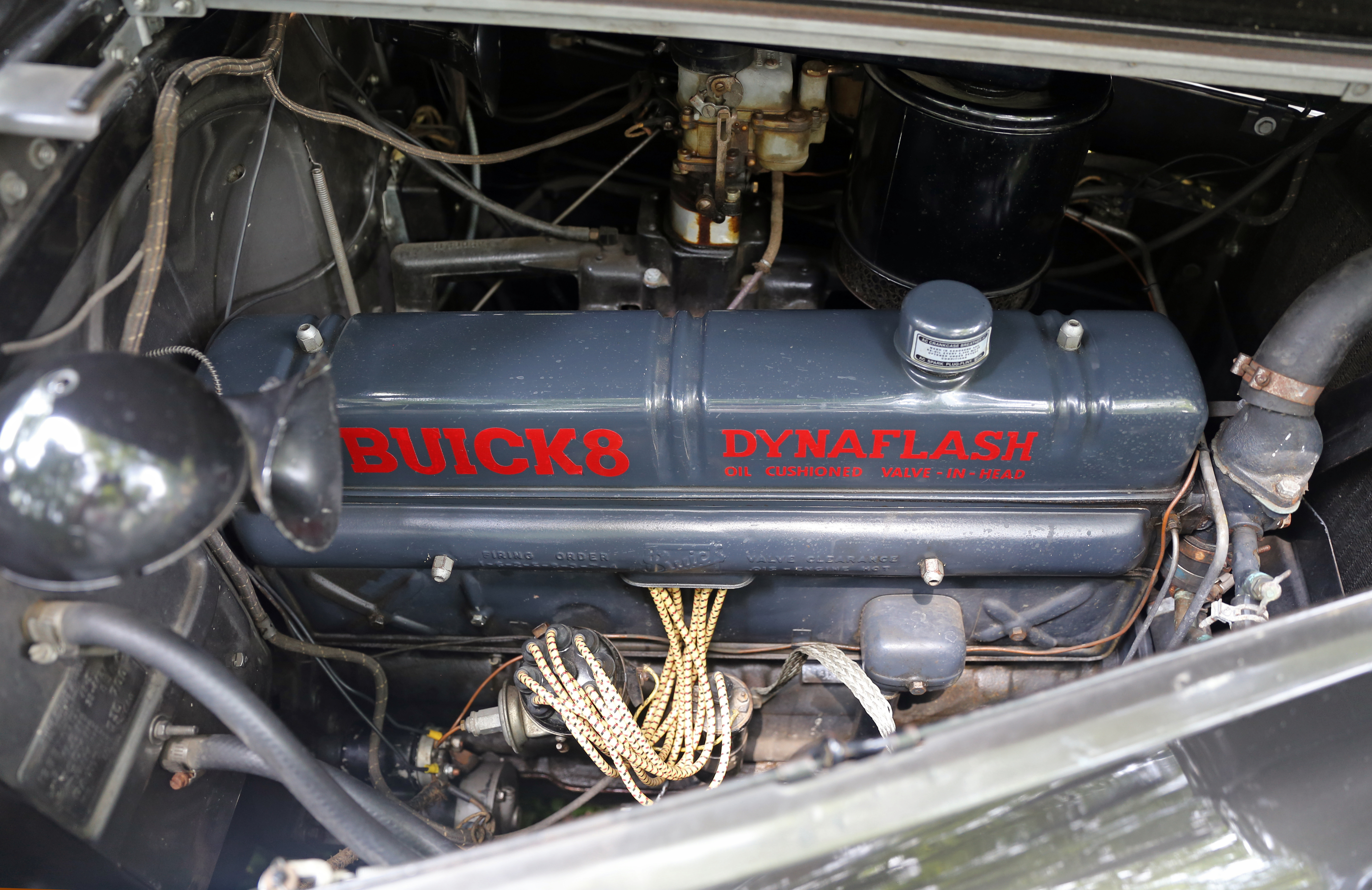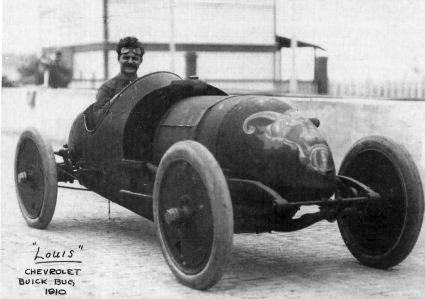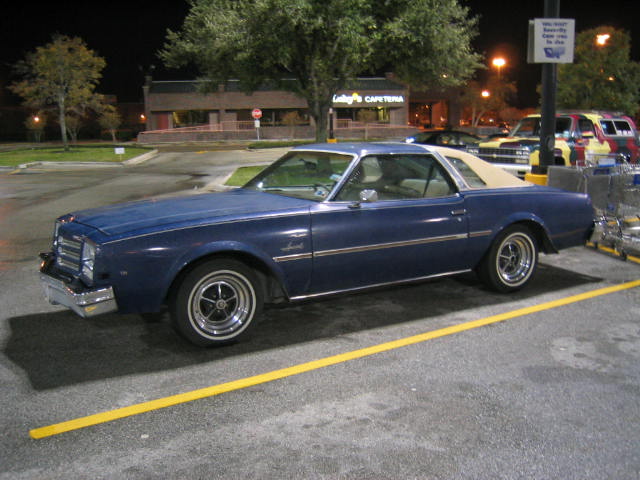|
Buick Straight-8 Engine
The Buick Straight-8 engine (Fireball 8) was produced from 1931 to 1953 and sold in Buick automobiles, replacing the Buick Straight-6 engine across the board in all models in 1931. Like many American automobile makers, Buick adopted the straight-eight engine in 1931 as a more powerful alternative to the previous engines. Design Unlike most other car makers at the time, Buick had been using a valve-in-head/OHV overhead valve reverse-flow cylinder head design or I-head since their inception and continued this practice in their straight-eight designs. The engine was sold in different displacements depending on the model of car and the year and was constructed upon two distinct (possibly more) block castings. The engine block in the smaller displacement versions internally resembled the 1937-53 inline Chevrolet 216, 235 & 261" straight six (the combustion chamber design was quite different), albeit with additional cylinders. The large block version (320 cid and 345 cid; use ... [...More Info...] [...Related Items...] OR: [Wikipedia] [Google] [Baidu] |
Buick
Buick () is a division of the American automobile manufacturer General Motors (GM). Started by automotive pioneer David Dunbar Buick in 1899, it was among the first American marques of automobiles, and was the company that established General Motors in 1908. Before the establishment of General Motors, GM founder William C. Durant had served as Buick's general manager and major investor. In the North American market, Buick is a premium automobile brand, selling luxury vehicles positioned above GM's mainstream brands, while priced below the flagship luxury Cadillac division. Buick's current target demographic according to ''The Detroit News'' is "a successful executive with family." After securing its market position in the late 1930s, when junior companion brand Marquette and Cadillac junior brand LaSalle were discontinued, Buick was positioned as an upscale luxury car below the Cadillac. During this same time period, many manufacturers were introducing V8 engines in their ... [...More Info...] [...Related Items...] OR: [Wikipedia] [Google] [Baidu] |
Reverse-flow Cylinder Head
In engine technology, a reverse-flow or non-crossflow cylinder head is one that locates the intake and exhaust ports on the same side of the engine. The gases can be thought to enter the cylinder head and then change direction to exit the head. This is in contrast to the crossflow cylinder head design. Advantages The main advantage of the reverse-flow cylinder head is that both the entering inlet charge and the exiting exhaust gas cause a tendency to swirl in the same direction in the combustion chamber. In a crossflow head the inlet and exhaust gases promote swirl in opposite directions so that during overlap the swirl changes directions. The constant swirl during overlap which results in a reverse-flow cylinder head promotes better mixing, hence better scavenging of the end gas. The fact that the inlet charge must change direction before exiting the exhaust makes it less likely that fresh mixture will exit the exhaust before mixing during overlap. Overall this improves volu ... [...More Info...] [...Related Items...] OR: [Wikipedia] [Google] [Baidu] |
Buick Engines
Buick () is a division (business), division of the United States, American automobile manufacturer General Motors (GM). Started by automotive pioneer David Dunbar Buick in 1899, it was among the first American Brand, marques of automobiles, and was the company that established General Motors in 1908. Before the establishment of General Motors, GM founder William C. Durant had served as Buick's general manager and major investor. In the North American market, Buick is a premium automobile brand, selling luxury vehicles positioned above GM's mainstream brands, while priced below the flagship luxury Cadillac division. Buick's current target demographic according to ''The Detroit News'' is "a successful executive with family." After securing its market position in the late 1930s, when junior companion brand Marquette (automobile), Marquette and Cadillac junior brand LaSalle (automobile), LaSalle were discontinued, Buick was positioned as an upscale luxury car below the Cadillac. Duri ... [...More Info...] [...Related Items...] OR: [Wikipedia] [Google] [Baidu] |
List Of GM Engines
This list of GM engines encompasses all engines manufactured by General Motors and used in their cars. Divisions When General Motors was created in 1908, it started out with Buick and soon after acquired Oldsmobile, Cadillac and Oakland. There were dozens of other smaller companies that William Durant acquired during his first employment term until he was let go due to financially overextending his purchases. He regained control when he brought on Chevrolet in 1917 which was short lived until he was let go for the second time. This meant that the different core brands designed and manufactured their own engines with few interchangeable parts between brands, while sharing chassis, suspension and transmissions. One of the companies Durant bought in 1909 was the Northway Motor and Manufacturing Company founded by Ralph Northway who had previously supplied engines to Buick, Oakland, Cartercar and other 1900s manufacturers, including V8 engines to Oldsmobile, Oakland and Cadillac when ... [...More Info...] [...Related Items...] OR: [Wikipedia] [Google] [Baidu] |
Buick V6 Engine
The Buick V6, popularly referred to as the 3800 in its later incarnations, originally and initially marketed as ''Fireball'' at its introduction in 1962, was a large V6 engine used by General Motors. The block is made of cast iron and all use two-valve-per-cylinder iron heads, actuated by pushrods. The engine, originally designed and manufactured in the United States, was also produced in later versions in Australia. It was the first six-cylinder engine designed exclusively for Buick products since the Buick straight-six was discontinued in 1930. The 3800 was on the Ward's 10 Best Engines of the 20th century list, made Ward's yearly 10 Best list multiple times, and is one of the most-produced engines in history. To date, over 25 million have been produced. In 1967, GM sold the design to Kaiser-Jeep. The muscle car era had taken hold, and GM no longer felt the need to produce a V6, considered an unusual engine configuration in North America at the time. The energy crisis a decad ... [...More Info...] [...Related Items...] OR: [Wikipedia] [Google] [Baidu] |
1939 Buick Dynaflash Inline-eight In A Series 40 Special
This year also marks the start of the Second World War, the largest and deadliest conflict in human history. Events Below, the events of World War II have the "WWII" prefix. January * January 1 ** Third Reich *** Jews are forbidden to work with Germans. *** The Youth Protection Act was passed on April 30, 1938 and the Working Hours Regulations came into effect. *** The Jews name change decree has gone into effect. ** The rest of the world *** In Spain, it becomes a duty of all young women under 25 to complete compulsory work service for one year. *** First edition of the Vienna New Year's Concert. *** The company of technology and manufacturing scientific instruments Hewlett-Packard, was founded in a garage in Palo Alto, California, by William (Bill) Hewlett and David Packard. This garage is now considered the birthplace of Silicon Valley. *** Sydney, in Australia, records temperature of 45 ˚C, the highest record for the city. *** Philipp Etter took over as Swiss Fed ... [...More Info...] [...Related Items...] OR: [Wikipedia] [Google] [Baidu] |
Buick Special
The Buick Special was an automobile produced by Buick. It was usually Buick's lowest-priced model, starting out as a full-size car in 1936 and returning in 1961 (after a two-year hiatus) as a mid-size. The Special was built for several decades and was offered as a coupe, sedan and later as a station wagon. When GM modernized their entry level products in the 1960s, the Special introduced the modern Buick V6 that became the core engine for GM for several decades and lives on in current upgraded V6 products. By 1970, Special was no longer offered as a standalone model but the name would later be used for the entry trim on 1975 to 1979 and 1991 to 1996 Century models. The entry level Buick can trace its heritage to the Buick Model 10, a companion to Buick's first car, the Buick Model B. The Model 10 started out as one of the independent brands merged into Buick, called the Janney. Series 40 (1930, 1934–1935) When the Series 40 was introduced, it had the overhead valve Buick S ... [...More Info...] [...Related Items...] OR: [Wikipedia] [Google] [Baidu] |
Buick Roadmaster
The Buick Roadmaster is an automobile that was built by Buick from 1936 until 1942, from 1946 until 1958, and then again from 1991 until 1996. Roadmasters produced between 1936 and 1958 were built on Buick's longest non-limousine wheelbase and shared their basic structure with the entry-level Cadillac Series 65, the Buick Limited, and after 1940, the Oldsmobile 98. Between 1946 and 1957 the Roadmaster served as Buick's flagship. When it was resurrected for the 1991 through 1996 model years, it became the marque's largest vehicle. The Roadmaster sedan, a C-body vehicle over its eight previous generations, shared the B-body for the first time in its history. It was longer with a greater wheelbase than the C-body Buick Park Avenue. It was also larger both in wheelbase () and overall length () than the K-body Cadillac DeVille. 1931-1933 The 1932 Series 80 was the first Buick with the OHV Buick Straight-8 engine developing at 2800 rpm. It was positioned as an upper catego ... [...More Info...] [...Related Items...] OR: [Wikipedia] [Google] [Baidu] |
Engine Displacement
Engine displacement is the measure of the cylinder volume swept by all of the pistons of a piston engine, excluding the combustion chambers. It is commonly used as an expression of an engine's size, and by extension as a loose indicator of the power an engine might be capable of producing and the amount of fuel it should be expected to consume. For this reason displacement is one of the measures often used in advertising, as well as regulating, motor vehicles. It is usually expressed using the metric units of cubic centimetres (cc or cm3, equivalent to millilitres) or litres (l or L), orparticularly in the United States cubic inches (CID, cu in, or in3). Definition The overall displacement for a typical reciprocating piston engine is calculated by multiplying together three values; the distance travelled by the piston (the stroke length), the circular area of the cylinder, and the number of cylinders in the whole engine. The formula is: : \text = \text \times \frac \times ... [...More Info...] [...Related Items...] OR: [Wikipedia] [Google] [Baidu] |
Overhead Valve
An overhead valve (OHV) engine, sometimes called a ''pushrod engine'', is a piston engine whose valves are located in the cylinder head above the combustion chamber. This contrasts with earlier flathead engines, where the valves were located below the combustion chamber in the engine block. Although an overhead camshaft (OHC) engine also has overhead valves, the common usage of the term "overhead valve engine" is limited to engines where the camshaft is located in the engine block. In these traditional OHV engines, the motion of the camshaft is transferred using pushrods (hence the term "pushrod engine") and rocker arms to operate the valves at the top of the engine. Some early intake-over-exhaust engines used a hybrid design combining elements of both side-valves and overhead valves. History Predecessors The first internal combustion engines were based on steam engines and therefore used slide valves. This was the case for the first Otto engine, which was first succ ... [...More Info...] [...Related Items...] OR: [Wikipedia] [Google] [Baidu] |
General Motors
The General Motors Company (GM) is an American Multinational corporation, multinational Automotive industry, automotive manufacturing company headquartered in Detroit, Michigan, United States. It is the largest automaker in the United States and was the largest in the world for 77 years before losing the top spot to Toyota in 2008. General Motors operates manufacturing plants in eight countries. Its four core automobile brands are Chevrolet, Buick, GMC (automobile), GMC, and Cadillac. It also holds interests in Chinese brands Wuling Motors and Baojun as well as DMAX (engines), DMAX via joint ventures. Additionally, GM also owns the BrightDrop delivery vehicle manufacturer, GM Defense, a namesake Defense vehicles division which produces military vehicles for the United States government and military; the vehicle safety, security, and information services provider OnStar; the auto parts company ACDelco, a GM Financial, namesake financial lending service; and majority ownership in t ... [...More Info...] [...Related Items...] OR: [Wikipedia] [Google] [Baidu] |
Straight-eight Engine
The straight-eight engine (also referred to as an inline-eight engine; abbreviated I8 or L8) is a piston engine with eight cylinders arranged in a straight line along the crankshaft. The number of cylinders and perfect primary and secondary engine balance resulted in smooth running, however there are several downsides relating to the significant length of the engine. Straight-eight engines were popular in luxury cars and racing cars in the 1920s to 1940s. During the 1950s, straight-eight engines were largely replaced by the more compact V8 engine design. Design A straight-eight can achieve perfect primary balance and secondary balance if an appropriate firing order is used. Like most other engines, torsional vibration of the crankshaft requires that a harmonic damper is installed on the crankshaft. at the accessory end of the crankshaft. As per other engines with 8 cylinders, the power delivery is smoother than engines with fewer cylinders. In the early 20th century, these sm ... [...More Info...] [...Related Items...] OR: [Wikipedia] [Google] [Baidu] |





.jpg)



